New Year's in Vienna
New Year’s is one of the few holidays the whole world celebrates together within a 24-hour period. My husband, Fred, and I, embarked on an unusual and offbeat travel adventure to greet the new year in Vienna, Austria.
Every year at home for the past decade, we’d watch Walter Cronkite narrate the annual New Year’s Day Concert of the Vienna Philharmonic Orchestra on PBS TV WNET, which is also broadcast worldwide. We’d absorb the sights of spacious, ornate marble palace corridors and sweeping staircases and marvel at the power and beauty of these world-renowned musicians and promise each other that one day we’d be there. Mr. Cronkite, though a famous journalist, is also a compelling tour guide of unmatched enthusiasm. He probably drums up lots of tourism for Vienna, along with the fine symphonies of the many orchestras and places of this magnificent centuries-old city.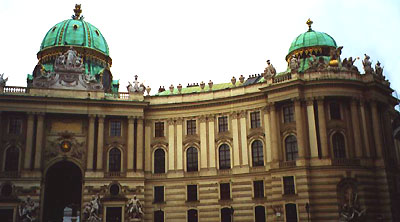
Vienna, home to 1.5 million people, is still a cultural Mecca of Old World Europe and also is home to some of the most remarkable art works and music.
We departed on an early evening flight and marveled at the Manhattan Skyline and bridges ablaze in light against a darkened sky. Night had just fallen and we settled in with dinner and a smooth flight. Of course, flying coach doesn’t allow for much leg or stretch room. Fred couldn’t sleep but I managed a few disturbed catnaps while curled in a fetal position, punctuated by his restlessness. His 6’3” figure seemed like a sardine packed in a can.
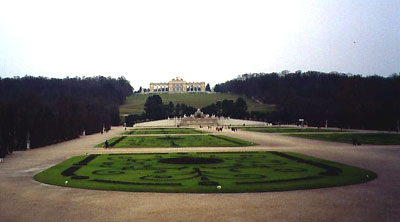 There was, however, no jet lag for us. The first thing we did after checking in at our hotel was take to the streets on foot. It was very cold and had the ambiance of an animated history book, complete with alternating gray skies and snow flurries that accentuated the Old World feeling. We trudged briskly down pedestrian squares of cobblestone passageways flanked by boutiques, antique shops and restaurants. We sought out and found the famous 200 year old Demel’s Coffee Shop, a place made out of mahogany wood, huge crystal chandeliers and offering hundreds of delectable delights. Europeans treasure history in everything – down to dessert.
There was, however, no jet lag for us. The first thing we did after checking in at our hotel was take to the streets on foot. It was very cold and had the ambiance of an animated history book, complete with alternating gray skies and snow flurries that accentuated the Old World feeling. We trudged briskly down pedestrian squares of cobblestone passageways flanked by boutiques, antique shops and restaurants. We sought out and found the famous 200 year old Demel’s Coffee Shop, a place made out of mahogany wood, huge crystal chandeliers and offering hundreds of delectable delights. Europeans treasure history in everything – down to dessert.
Stately Vienna (Wien in German) was constructed in circular fashion with the tall St. Stephansdom Church at its center. Our hotel, aptly named Hotel Stephensplatz, was directly across the street. The cathedral with its towering spires is the city trademark on most souvenirs. It is a masterpiece of detailed architecture with mosaic tile roof that must have served as inspiration for later structures. It was built with the help of Rudolph IV in the 1300s. He was successor to the Austrian Habsburg Family throne when his father, Albert, died of a mysterious illness.
An elevator brought us up one tower where we found ourselves on a rickety round catwalk that trimmed the spire, as we marveled at the sweeping city panorama.
On the second day, we met up with our tour guide, Emmi Glatzer, for our first official group tour to Schoenbrunn Palace and a few pages back in our history books.
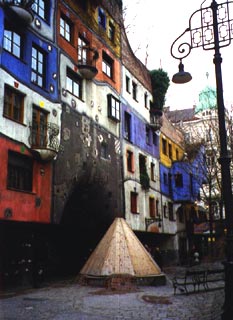 The Habsburg Family ruled Austria for 600 years. Their summer dwelling, a mere weekend getaway of several hundred rooms, of which 20 are opened to the public and are known as the State Apartments, are overwhelming and indescribable in opulence. Queen Maria Theresa spent her summers here. There are walkways in between the walls so servants of long ago could stoke the fireplaces without disturbing the royal household members or their guests. It is a visionary overload of cherubs, chandeliers and gold inlaid furniture. Some of her china reminded me of my late mother’s Bavarian china, which, coincidentally, the pattern is also named “Maria Theresa”. Maria Theresa ruled in the 1700s, a time when the Habsburg Empire was weakening because of Prussia’s power. While the palace rooms were breathtaking, it was the Widow’s Room, black and somber, though still ornate, that impressed me most. One can feel her grief over the loss of her husband. I knew instinctively before the tour guide said so.
The Habsburg Family ruled Austria for 600 years. Their summer dwelling, a mere weekend getaway of several hundred rooms, of which 20 are opened to the public and are known as the State Apartments, are overwhelming and indescribable in opulence. Queen Maria Theresa spent her summers here. There are walkways in between the walls so servants of long ago could stoke the fireplaces without disturbing the royal household members or their guests. It is a visionary overload of cherubs, chandeliers and gold inlaid furniture. Some of her china reminded me of my late mother’s Bavarian china, which, coincidentally, the pattern is also named “Maria Theresa”. Maria Theresa ruled in the 1700s, a time when the Habsburg Empire was weakening because of Prussia’s power. While the palace rooms were breathtaking, it was the Widow’s Room, black and somber, though still ornate, that impressed me most. One can feel her grief over the loss of her husband. I knew instinctively before the tour guide said so.
Emperor Frances Joseph, her husband, spent the end of his life in the sprawling Schoenbrunn Palace. He enjoyed walking in his garden where he was hidden amongst the many rose bushes. The second story of the right wing had an apartment known as the Imperial Apartment, accessible via a courtyard entrance and up a flight of marble steps. It consisted of a reception room, office and royal bedroom.
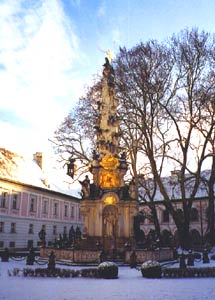 Historical legend tells that blackbirds swarmed the palace grounds and then disappeared upon dissolution of the last remaining vestige of Habsburg royalty. I saw some blackbirds out back. under a misty, damp, gray sky and bone-chilling cold. “Back” stretched for many acres of rose gardens, hedges, mazes and a monumental, columned structure that trimmed the landscape.
Historical legend tells that blackbirds swarmed the palace grounds and then disappeared upon dissolution of the last remaining vestige of Habsburg royalty. I saw some blackbirds out back. under a misty, damp, gray sky and bone-chilling cold. “Back” stretched for many acres of rose gardens, hedges, mazes and a monumental, columned structure that trimmed the landscape.
As a contrast, our tour stopped in a Soho-type section of Vienna that housed unusual colorful buildings of pop art and deliberate crooked floors by a whimsical artist-architect with sense of offbeat humor.
The following day brought us to the exclusive “suburbs” of the Vienna Woods some forty minutes outside of the city. The bucolic countryside served as inspiration and subject of many songs written by the great composers, among them, Johann Strauss, with its charming villages, hills and turns. A most magnificent sight was a medieval castle perched erect on a hill that dotted the landscape of pines and hilly horizon. We went to the Abbey of Heiligenkreuz, a monastery, where we drank from a natural spring water well shared by monks six centuries ago and poked through rooms of altars and carved pews and wooden statues of Christ and saints, all hand-carved by monks of long ago. The dusting of snow set the mood perfectly. Outside in one of the courtyards is a monument to the Plague of 15th Century Europe, identical to the one in the square in the city. They build these monuments hundreds of years ago to thank God for all who did survive the scourge that claimed the lives of thousands in Medieval Europe.
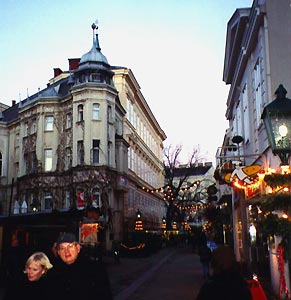 The original stained glass windows of the Abbey, built in the 1100s were created from black and white glass only. The mentality was that colors would distract or trap the five human senses and arrest one’s spiritual growth thereby preventing one from worshipping God only, not man-made creations. Later on (two centuries or so), colors were introduced, as evidenced in subsequent additions of Abbey Chapels.
The original stained glass windows of the Abbey, built in the 1100s were created from black and white glass only. The mentality was that colors would distract or trap the five human senses and arrest one’s spiritual growth thereby preventing one from worshipping God only, not man-made creations. Later on (two centuries or so), colors were introduced, as evidenced in subsequent additions of Abbey Chapels.
The Death Room was macabre; all sorts of demonic-like figurines flanked a coffin and altar.
Not far from the Abbey was Meyerling, the former Imperial Hunting Lodge, and infamous sight in history. On January 28, 1889, a date with destiny, Crown Prince Rudolph and his lover, Mary Vetsera, were found dead in bed. Their deaths remain a mystery in Austrian history. Some say a scandal was squelched and they both committed suicide, but Emperor Frances Joseph converted the hunting lodge into a private Carmelite Nuns’ monastery.
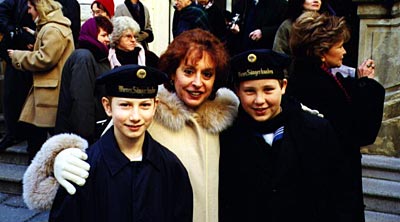 We returned to Vienna via the charming town of Baden, home of therapeutic spas and mineral baths. In the summer, the surroundings smell like rotten eggs from the sulpher, our tour guide explained. We strolled the tiny hilly streets, shopped and drank hot apple cider laced with whiskey at a local street fair. It helped fight the elements.
We returned to Vienna via the charming town of Baden, home of therapeutic spas and mineral baths. In the summer, the surroundings smell like rotten eggs from the sulpher, our tour guide explained. We strolled the tiny hilly streets, shopped and drank hot apple cider laced with whiskey at a local street fair. It helped fight the elements.
Sunday was New Year’s Eve and we went to morning Mass in the Imperial Palace Chapel and heard the Vienna Boys’ Choir. They sounded like bells instead of human voices. They were deliberately positioned so no one could see them in the choir loft. After Mass, they came outside and posed in street attire for photos with us. They ranged in ages from eight to fourteen and looked like innocent pubescent and adolescent boys in their berets.
 Then the magical evening arrived. The Wiener Musikverein Konzerthaus was trimmed in gold inlaid moldings and the floor to high ceiling pipes of the organ were flanked in hundreds of gladiolas and lilies and pinks and whites and reds. It was the Dress Rehearsal of the Vienna Philharmonic Orchestra New Year’s Day Concert and it coincided with the Emperor’s Ball on the Eve.
Then the magical evening arrived. The Wiener Musikverein Konzerthaus was trimmed in gold inlaid moldings and the floor to high ceiling pipes of the organ were flanked in hundreds of gladiolas and lilies and pinks and whites and reds. It was the Dress Rehearsal of the Vienna Philharmonic Orchestra New Year’s Day Concert and it coincided with the Emperor’s Ball on the Eve.
As we were going directly to the Imperial Palace afterwards, Fred and I went dressed for the Kaiser Ball, he in his black tuxedo and I in an ice pink gown. The New Year’s Day Concert next morning was long sold out and beyond our means, so we settled – just as ecstatic – for the Dress Rehearsal the night before.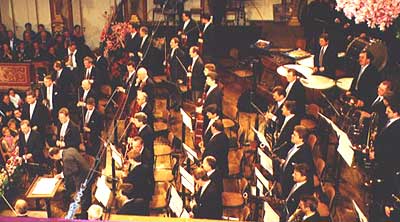
We climbed four flights up to our balcony seats in the old, stately Konzerthaus, directly adjacent to the flowers, which we could smell – and, it seems, almost reach over and touch – and directly above and to the right-hand side of the orchestra. The view was perfect. I huffed and puffed all the way up, holding my gown around me, while imprisoned in white satin spiked heels.
We knew we were somewhere special. It looked like the place we came to know so well on television only this time we were part of it. We were actually in this colorful extravaganza. The crowds of people from all over the world were also dressed in formal regalia. This was the moment we waited ten years for. We spent the first ten minutes shell-shocked and spellbound. The music was divine and the intense, animated facial expressions of the conductor were equally moving.
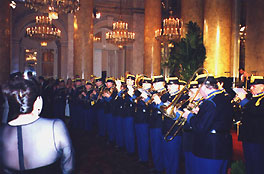
Tall Fred, who looked like a dapper movie star, quite at home in the midst of splendor, had a look on his face that was worth a thousand words. We stood, held hands and swayed to the heavenly strains of the Blue Danube.
The Imperial Palace, also known as the Hofburg, is a semi-circular, sweeping, formidable, imposing structure. In 1948 rebels stormed the palace, but on New Year’s Eve 2001 we and thousands of others took the place by storm for the Emperor’s Ball.
The history of the Habsburg Family is fraught with chaos, love affairs, mysterious deaths, disappearances, infighting, wars and revenge. So what else is new?
I had other things on my mind, like Cinderella. The tour operator warned me that the annual Kaiser Ball is extremely crowded. I had no ordinary gown for two reasons. One, it was a Jessica McClintock flounced voile gown of several crinolines with a pink satin bustier. While beautiful, it was actually quite uncomfortable to wear. (Gee, they never mentioned that in the fairytales!) The second reason my gown was unusual, was the price. I discovered it on the racks at a local store for 60% off a series of prior reductions. They weren’t kidding. The final register tab at the checkout read a whopping $13.78, tax included. I wonder what the royals would have said about that!
I was afraid someone would catch an edge of my gown and, in stepping on it, loosen the skirt completely from the top and I’d look like Madonna, the rock star, when she wore next to nothing on stage. Could I bring disgrace to an already “decadent” affair? I wondered, did royalty, whom we were imitating by ringing in the New Year just as they did for many centuries, see their ostentatious environs as the same old hat after a while? Did these gilded halls become routine? Drudgery? Did they feel elegant in these bigger-than-life, cumbersome and isolating getups?

I wore my mother’s “Aurora Borealis” Austrian crystal necklace for the first time ever. The clear beads shimmered pink.
It seemed like the whole world came. In the crunch of several thousand wannabe “royals”, we posed with mock guards at the palace entrance and proceeded inside to a majestic stairwell where every couple posed at the landing by a statue of Beethoven and massive flowing palms for pictures. It took an eternity to climb to the top, as we were packed in on each step. For a moment, it felt more like the New York Subway at rush hour than the Imperial Palace in Vienna.
Here we were at The Ball of a Lifetime and my feet were already throbbing miserably before our first dance. I was no Cinderella; more like the wicked stepmother whose bulging feet were too big for the shoe. Oh, well. At least I was in the right story.
We explored each of the myriad ballrooms that had rows of table and chairs and different musicians dressed in period costumes playing a variety of music. It felt like one giant wedding and we women were all brides. One looked exactly like Scarlett O’Hara in her puffed green gown.
At Midnight the Main Ballroom bustled with ballerina dancers emerging from a giant Coo Coo Clock with Roman numerals high on a ledge above the orchestra. Lasers reflected “Happy New Year” in many languages all over the ceiling at the stroke of Midnight. The atmosphere was electrifying as we kissed and brought in the New Year in this 600-year-old palace across the ocean in Vienna.
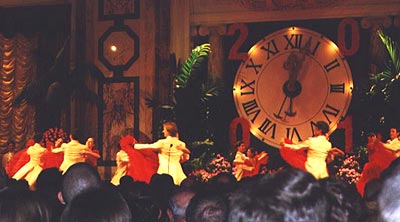
By miracle, we caught up with the other members of our tour group and spent the night sipping champagne, laughing and rubbing our swollen feet. Then the night caught up with me. True to Cinderella fashion, I dropped a shoe in the taxi. No, it wasn’t a horse and buggy, much to my dismay. And I wasn’t running from my Prince Charming; I was tipsy, so I stumbled on Fred’s arms back into our hotel.
Travel is a beautiful pause punctuating real life. It is conducive to romance. One makes journeys and takes places with one and also makes inner journeys as well. That night at the Ball, I met a fellow traveler who was named after St. Theresa of The Little Flower. Her great uncle had met the saint a century ago and I met the saint who named herself after her example, Mother Teresa. Here we were in an historical place of mammoth proportions and it was a homecoming of “saint-sightseers” and whom we knew.
There are so many sights and sounds to be captured in a trip to Europe. So familiar, the city is now ours. We enjoyed a burdenfuter, a huge sausage frankfurter-looking food on a hero.
One feels a connection with the world and all of civilization. Fred particularly felt this keenly. When one walks into a museum of history and sits in a stone chair unearthed from a Turkish Amphitheater in 400 BC, when one observes dogs and cats drinking from troughs in the square made expressly for them when being walked, and casual nudity on TV, alligator handbags and couches designed in the shape of a woman’s red lips, one realizes one is truly Someplace Else. Europeans are very human in ways we Americans have forgotten to be. For example, when one orders coffee in a cafe, it is served in a fancy ceramic creamer, unlike the sterile metal container or tiny plastic throwaway package here. And, it is served with a glass of water. It’s all in the details.
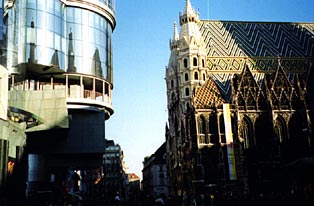
Old and new seem juxtaposed serenely. Trolley cars still whiz by as folks talking on cell phones and wrapped in animal furs step lively. The pig is a Vienna icon. There are pink pig pastries and cakes in store windows and pink pig hats. We saw a student protest march from the local University in the square, accompanied by heavy police presence one night. Once a week they demonstrate against a recent government decision not to subsidize college education anymore. And the church bells ring out every hour on the hour and fifteen minutes before daily Mass as wood-burning aromas permeate the brisk winter air. Vienna is a predominantly Catholic country.
But the Viennese, to these two Americans, don’t seem to be worried about not being politically correct. Smoking is allowed everywhere. Casual sex dominates television entertainment, especially in advertisements. They seem comfortable with it and there is no shame.
Europe is a straight run, just around the corner, another neighborhood to explore. On the gateway edge of the world to places so familiar, one is reminded of them in an instant and awe-inspired at the same time. You’ll always know where you’ve been.
This New Year’s Day we will be home again. The trip to Vienna will seem like the life pause it was, as if in a dream. But this time we’ll watch the Vienna Philharmonic Orchestra New Year’s Day Concert from Vienna and look at each other and incredulously exclaim, “Wow! We were there?”
